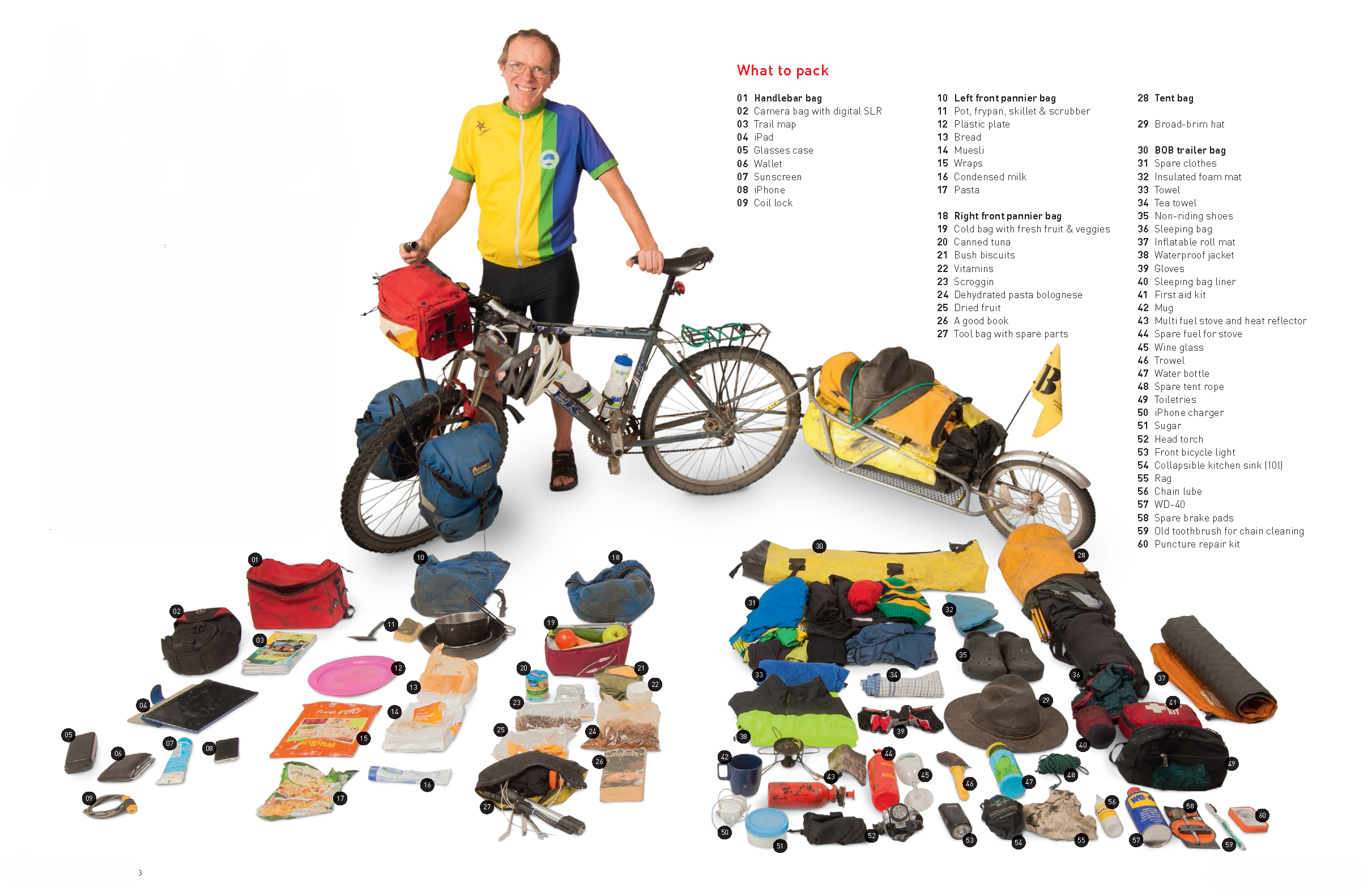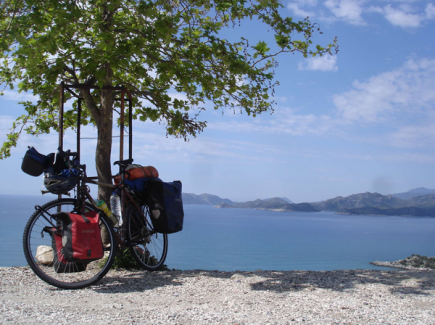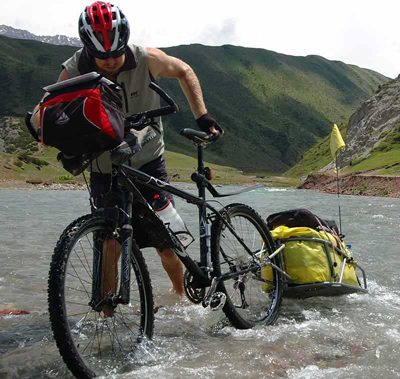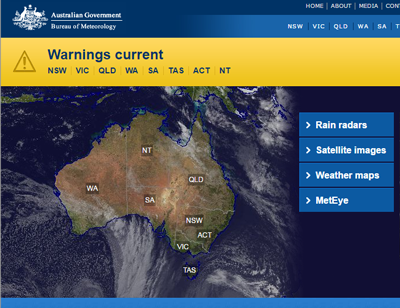Not just for A to B, Damian Antonio can show you how to use your bike to go from A to B to C, spend the night at D, have lunch at E and then cycle back to A. Tip, you’re going to need more than your bike pump and a banana.
Cycling is a fantastic way to see the world. The scenery passes you by at a leisurely 20 kilometres per hour, as opposed to a blurry 110. Your ears are free to tune into the chirping of birds and local wildlife, rather than the same three CDs you’ve had in your car since 1999. Your nostrils are open to all the scents the world has to offer, as opposed to the stale pine air freshener hanging off your rear view mirror. You can easily talk to and befriend the locals.
It’s the perfect way of having a refreshing weekend getaway while inviting a certain spontaneity into your trip that doesn’t exist with faster forms of transport. But how do you plan for it and what do you need?
Planning and preparation
The first thing to decide for any vacation is where you want to go. For a cycling trip, it’s no different, except that you need to consider not just the destination, but also the journey.
You may know of an idyllic, secluded beach that looks like it’s straight out of the final scene of a James Bond film, but if the only way to get there is to cycle 90 miles along a narrow, rocky road plied by coal trucks, then it’s probably not the best destination for a cycling trip.
In assessing a suitable route, you need to throw a jumble of questions into the melting pot and see what answers comes out. Where do I want to start? How far do I want to ride? How far can I ride? What is the quality of the roads and level of traffic? What is the gradient? Is there food, water and accommodation along the way? Will I have mobile phone reception in case of an emergency? Are there any bike shops around in case of a breakdown? What is the weather forecast? The list goes on.
At a minimum, you should consider the following:
Starting point: I’m sure we’d all like to start and finish our rides at the front doors of our homes. And if you can, that’s great. The fact is, however, that many of us are urban dwellers and our weekend would be half over before we even made it out of the city—if we made it out. So work out where you’re actually going to start riding from and how you’re going to get there.
Tip: Trains are the easiest and cheapest form of public transport for you and your bike. Travel during off-peak times when there’s plenty of space and you don’t have to pay extra tariff on your bike.
Distance and gradient: The most critical question to ask yourself when assessing your route relates to distance: how far can I comfortably ride and how long will it take me? While there is something to be said for pushing your physical limits, you should always allow for contingencies, such as breakdowns and inclement weather. Also, you can’t assess distance without taking into account the gradient of the road—a steep five-kilometre hill may take ten minutes to roll down but an hour to climb up. Finally, you need to consider cumulative fatigue effects. While you may be good for 100 kilometres on day one, you might find that your body isn’t willing to do the same on days two and three.
Tip: If the furthest you’ve ever ridden is 40km, aim for 20km when hauling a load of luggage. You may want time when you arrive at your destination to set up camp or enjoy a sundowner at your accommodation.
Road and traffic conditions: What’s the point of going on a cycling holiday if you’re just going to suck on car fumes on the side of a highway? Consider whether the road on which you’ll be riding is “cycle-friendly” in terms of a reasonably smooth surface and traffic conditions that are pleasant and safe.
Tip: Google Maps allows you to do a virtual tour to check the road conditions and choose the most cycle-friendly roads available to you before you set off. You might also find handy advice from people who have ridden the same route, such as on the resource-heavy website, Crazy Guy On A Bike.
Fuel: One of the best things about bicycles is that they don’t require any fuel. Your body, however, certainly does. What’s more, your luggage will be a whole lot heftier if you decide to carry all of that fuel with you. Find out if food and water are available on your route, so that you know how much you need to carry to ensure you’re not running on empty.
Tip: When deciding how much water to carry, allow for consumption of approximately one litre per hour in moderate-hot conditions, in order to stay adequately hydrated.
In terms of the most important holiday concerns, the weather forecast ranks right up there alongside whether you can get someone to watch the kids while you hit cocktails by the pool. But people are generally only interested in the temperature and rainfall. On a bike trip, you need to also consider every cyclist’s worst enemy: the wind. A strong breeze blowing in the wrong direction will slow you down more than any hill and make you more miserable than any downpour. Also remember that some climates are very localised and meteorology is far from an exact science, so take a jacket just in case!
Luggage
Your choice of route and destination are big determining factors in whether you need to carry a small backpack containing little more than a spare sweater, or a full set of panniers filled with your winter gear, tool kit, tent and camp kitchen. In a world where it’s not uncommon to rent a storage unit to keep the stuff that won’t fit in your four-bedroom house, the question most people have when it comes to bike holidays and luggage is: how? How does one carry a weekend’s worth of stuff on a bicycle?
Well, there are a few options:
Backpack: While cheap and readily available, backpacks on a bike are the least recommended option. Sitting high above the road, they raise your overall centre of gravity making everything less stable and less safe. What’s more, they make your back sweat more than a sumo wrestler in a sauna.
Bikepacking: Bikepacking is a method of securing your gear to your bike using racks, bungee cords, ropes, straps, old shoelaces and whatever else you can find. While it’s cheap, lightweight and makes you feel like a true wandering nomad from a hippier time, bikepacking has got a fairly limited capacity and arranging it all can be rather tedious.
Panniers: Panniers are the rich man’s form of bikepacking and by far the most common way of carrying luggage on a bike. The pannier bags are easily secured to the bike’s racks and ensure a low centre of gravity, thus increasing stability. A set of four provides a large carrying capacity, but also makes your bike bulkier and increases wind resistance. Plus, they can be expensive.
Trailer: Bike trailer devotees are relatively few, but they are loyal. Trailers are great for carrying bulky loads, such as tents that won’t fit in panniers. The fact that their weight is close to the road and directly behind the bike means that handling isn’t affected too much. The downside is that they aren’t particularly manoeuvrable, they have mechanical parts that can break and require maintenance, and they are difficult to carry on planes and other public transport.

Equipment and skills
Somewhere tucked in your panniers or trailer should be some bike-specific equipment. Or not. It all depends on the level of independence you require, based on the duration of your trip, the location, climate, your skillset, where you intend to sleep and what you intend to eat.
If you’re planning a 20-kilometre summer ride through an urban area to an all-inclusive bed and breakfast, then you can probably get away with taking little more than your wallet and a change of undies. If on the other hand, you’re cycling 100 kilometres through the desert to camp on a mountaintop in the middle of winter, you’re going to want a few more things.
When figuring out what to carry, you need to weigh it all up…literally. Consider the likelihood that you will need a certain piece of equipment, the additional bulk and weight you will have to lug around, and the consequences of not having it if something goes wrong.
Also consider your skillset, which is inextricably linked to your equipment and spare parts. It’s no good carrying a chain tool if you don’t know how to repair a broken chain, just as it’s no good being an expert tube changer if you don’t have a pump.
At a minimum, all biking weekenders should probably be able to fix a flat tyre and make any minor adjustments or repairs using a set of Allen keys. As long as your bike is well maintained or had a recent service, you should be okay.
Of course, if you take enough cycling trips, eventually everything that can go wrong will go wrong. So perhaps the most important thing to take with you is a backup plan.
 Panniers
Panniers
Advantages
- Even weight distribution and low centre of gravity.
- Large total capacity for a full set, but manageable individual bag sizes.
- Versatile: Equally suited for a trip to the shops, or a 6-month tour of India.
- Can sometimes double as a daypack for use while off the bike.
Disadvantages
- Takes a little while to get used to the weight distribution on the bike (although that’s true of any method of carrying luggage).
- Increases the bike’s bulk and wind resistance.
- Increases the load on the wheels, which can potentially lead to more broken spokes and worn tires.
- Decent quality panniers can be expensive.
- Can make the bike unstable when parked.
 Trailers
Trailers
Advantages
- Good for carrying large, bulky items, such as a tent.
- Low centre of gravity directly behind the bike means that handling is not affected too much.
- Trailers are easy to detach from the bike for repairs or for riding without the burden of dragging a trailer.
- Very stable when parked and some trailers even double as a kickstand.
Disadvantages
- Bulky, heavy and not particularly manoeuvrable.
- Add complexity to your bike with more components that require maintenance and can break.
- Can be difficult for cars to see if not marked by something tall, such as a flag.
- Difficult to carry on planes, trains and other public transport.
Ride On content is editorially independent, but is supported financially by members of Bicycle Network. If you enjoy our articles and want to support the future publication of high-quality content, please consider helping out by becoming a member.



I absolutely love cycle touring
Me too!!!
I have just recently returned to cycle touring after a 45 yr hiatus, I love it as well, but having narrow roads here in the New England NSW is putting the wind up me. The road rules for clearances for bikes, I know them, virtually every car and truck driver in my area doesn’t, so having a lot of close calls is putting me off doing some serious travelling. If I travelled without my dog. had no wife or kids, I would probably take the risk more often. Here”s hoping I can get out there soon!
So if there was a small row boat that could take the fold up cycle and be towed by said bicycle with some bolt on wheels, we could all go a bit further. If it was a fold up tandem bike with a motor and a collapsible boat that that takes the bike ?
Great article! Is the second to last photo in croatia per chance?
In 2008 my wife and I spent four months cycle-camping through Western Europe (France, Germany, Switzerland and Austria). I had some of the best times I can remember.
One of life’s pleasures must be the first stroke of the pedal as you embark on a long cycle trip, with all summer ahead of you, traveling like a two-wheeled romany…
Just do it!